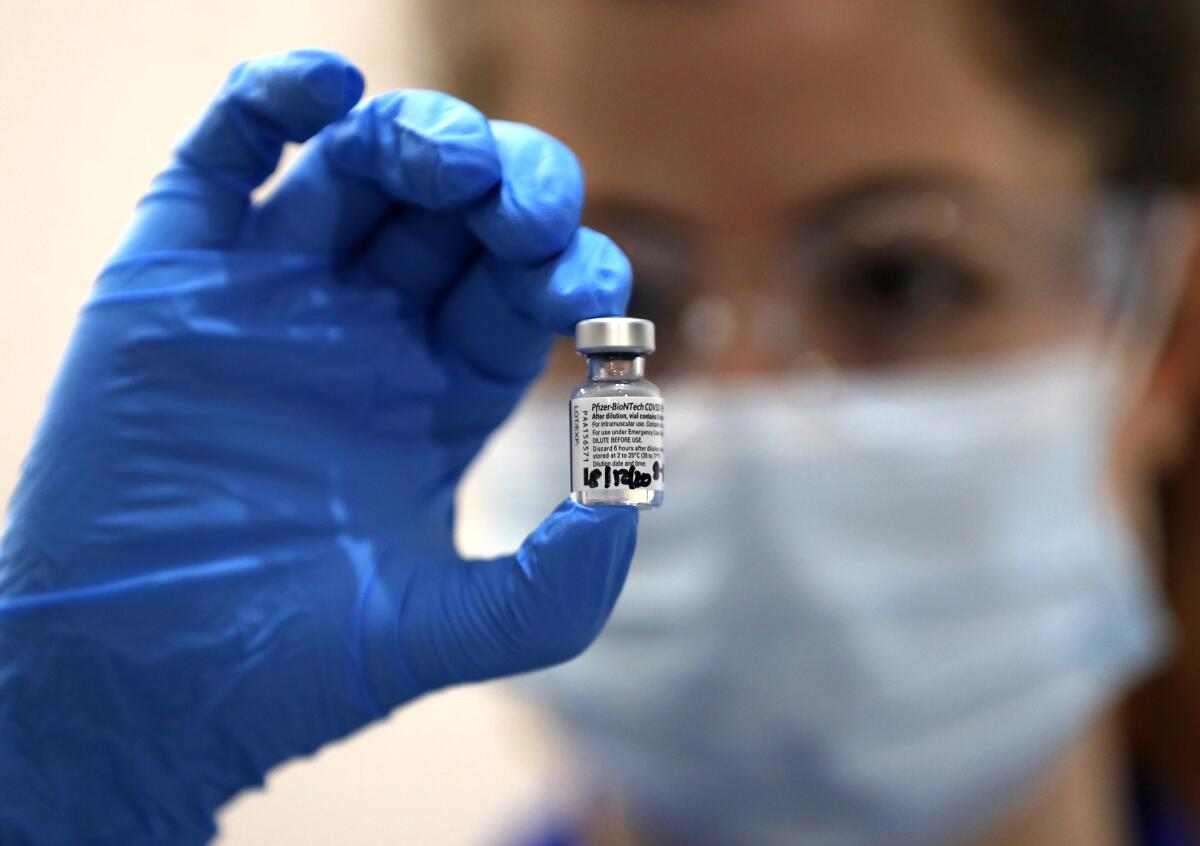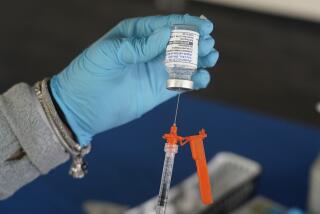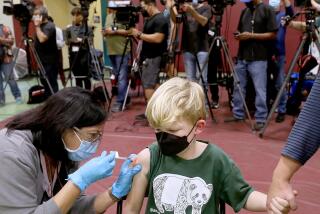COVID-19 vaccine clears key hurdle in California and much of the West

- Share via
The COVID-19 vaccine developed by Pfizer and BioNTech cleared another hurdle in California on Sunday, when a working group of scientists and experts endorsed its safety.
The group, representing California, Nevada, Oregon and Washington, reviewed the vaccine separately from the U.S. Food and Drug Administration, which on Friday issued emergency use authorization. The group made its recommendation to the governors of the four states Sunday morning, officials said in a news release.
The move paved the way for vaccines to be distributed across California. Los Angeles International Airport’s Twitter account said Sunday night that the first batch had arrived in L.A., with more to follow this month and in January.
“With shipments of the vaccine soon on their way to California,” Gov. Gavin Newsom said in a statement, “we are working hand-in-hand with local public health officials to get the vaccine out to the first phase of recipients.”
California’s first allocation of about 327,000 doses is being sent mostly to acute-care hospitals to be administered to healthcare workers, although some counties have said they will also send a portion to skilled nursing facilities. The vaccine isn’t expected to be available to everyone who wants it until the spring.
“We’re really living in and writing history right now,” said Desi Kotis, UC San Francisco Health’s chief pharmacy executive, who is leading the vaccine rollout there.
UC San Francisco Health expects to receive at least 975 doses Monday or Tuesday, followed by more shipments later in the week. If hospital officials obtain the first allocation by Tuesday, “which is a big hope,” Kotis said, they plan to start vaccinating people Wednesday morning.
The initial shipment won’t be enough to cover the 20,000 or so people affiliated with the healthcare system who need to be vaccinated, including staff at the UC San Francisco Benioff Children’s Hospital Oakland and multiple affiliate practices; the UC San Francisco police force; and students, staff and researchers at the UC San Francisco School of Medicine. Of those, UC San Francisco Health has prioritized 10,000 to 11,000 people because they’re at high risk of prolonged exposure to the coronavirus.
“It’s not just a doctor, a nurse or a pharmacist,” Kotis said. “It could be a physical therapist or occupational therapist working with a COVID patient. It’s a patient transporter moving COVID patients around the hospital and clinics. It’s the environmental service worker, the custodial worker who’s cleaning our facility.”
Others who will be prioritized include first responders, people who are working at coronavirus testing sites or administering vaccines, students in clinical rotations in high-risk areas like the emergency department and researchers actively working with COVID-19 patients or vaccines, Kotis said.
She said the hospital is being careful to vaccinate only about a third of any given work group at a time, so if employees suffer side effects and need a day off, enough workers remain to take care of patients.
The state Department of Public Health selected UC San Francisco Health as a vaccine distribution site in early November after it answered a detailed series of questions about its facilities, down to the detail of the serial numbers on its ultracold freezers for storing the vaccine, Kotis said. The hospital also had to attest that it would be willing to vaccinate patients and employees who aren’t affiliated with UC San Francisco.
Based on the latest instructions from health officials, UC San Francisco plans to use the initial doses of vaccine solely on its own employees and students, but that could change, and the hospital is “ready to pivot and do that work,” Kotis said.
“If our health department does say you may need to vaccinate others from long-term care facilities, whether it’s workers or residents, or other hospitals in the area, we will comply with the health department,” she said.
The health system hopes to have its high-risk workforce vaccinated by mid-January. Students and staff can opt out. UC San Francisco will then move on to the second group of people to be vaccinated, which includes essential workers and highest-risk patients. Discussions are already underway concerning how people will be prioritized within those groups, Kotis said.
News of the working group’s recommendation came as conditions continued to deteriorate at California’s hospitals. There were 13,047 COVID-19 patients hospitalized Saturday, according to data released Sunday by the state. That’s a nearly sixfold increase from two months ago, when there were 2,226 patients.
L.A. County saw hospitalizations increase by roughly the same proportion, logging 4,203 patients on Saturday, compared with 723 two months before. County public health officials on Sunday reported 29 deaths from COVID-19 and 12,731 new coronavirus cases, marking the fourth consecutive day the number of new cases topped 11,000. The high figures came despite the fact that case numbers are usually lower on weekends because some laboratories don’t report results.
As trucks carrying the vaccine departed Pfizer’s manufacturing plant near Kalamazoo, Mich., on Sunday, advocates sought to dispel skepticism about a drug that could save lives.
Dr. Francis Collins, director of the National Institutes of Health, said the level of scrutiny to which the vaccine had been subjected was unprecedented and that the data detailing its safety and efficacy were publicly available.
“This is a very powerful outcome of this incredibly intense yearlong experience to develop this,” Collins said on NBC’s “Meet the Press.” “And I think all reasonable people, if they had the chance to sort of put the noise aside and disregard all those terrible conspiracy theories, would look at this and say, ‘I want this for my family; I want it for myself.’”
Collins acknowledged that the sense the vaccine development was rushed, plus the “terrible polarization” in the country, created a sense of skepticism. But, he said, it was unfounded.
Collins also cautioned that just because a vaccine is being rolled out, other steps in health safety should not be discarded.
“Masks are still going to be part of our life,” he said. “We need to recognize that and not step away or start to drop our guard.”
Kotis echoed that sentiment.
“There’s still going to be time where we have to abide by the rules and mask and distance and keep our hands clean and not party like it’s 1999 and go to a big rave tomorrow night because I got my vaccine,” she said. “We’re still going to have to be patient, and it’s going to take time. But the light at the end of the tunnel isn’t a train coming back at us anymore. It’s a bright beacon of hope.”
Jay Inslee, the Democratic governor of Washington, said the review by the four states should help assure residents of the region.
“It was crucial that the Western states had their own independent review of the vaccine,” Inslee said in a statement, “so we can have additional confidence on its safety and efficacy before we start administering to the people of our states.”
More to Read
Sign up for Essential California
The most important California stories and recommendations in your inbox every morning.
You may occasionally receive promotional content from the Los Angeles Times.












